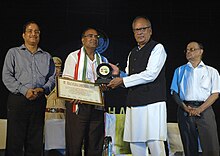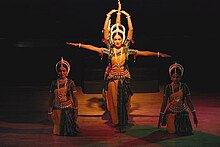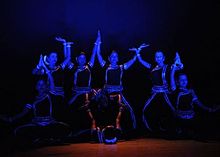| Revision as of 17:38, 29 January 2014 editRoland zh (talk | contribs)Autopatrolled, Extended confirmed users, Pending changes reviewers121,090 editsm commonscat← Previous edit | Revision as of 07:21, 19 August 2014 edit undoOhconfucius (talk | contribs)Autopatrolled, Extended confirmed users, Pending changes reviewers328,947 edits Script-assisted fixes per WP:TIES, MOS:NUM, MOS:LINKNext edit → | ||
| Line 1: | Line 1: | ||
| {{EngvarB|date=August 2014}} | |||
| {{Use dmy dates|date=August 2014}} | |||
| {{Infobox writer <!-- for more information see ] --> | {{Infobox writer <!-- for more information see ] --> | ||
| | image = Vanikavi Manmohan Acharya.jpg | | image = Vanikavi Manmohan Acharya.jpg | ||
| Line 4: | Line 6: | ||
| | pseudonym = Vanikavi | | pseudonym = Vanikavi | ||
| | birth_name = | | birth_name = | ||
| | birth_date = {{birth date and age|1967|10|20 |
| birth_date = {{birth date and age|df=yes|1967|10|20}} | ||
| | birth_place = ],<br />India | | birth_place = ],<br />India | ||
| | death_date = | | death_date = | ||
| | death_place = | | death_place = | ||
| | occupation = |
| occupation = Poet, script writer for], <br />Playwright essayist | ||
| | nationality = Indian | | nationality = Indian | ||
| | period = 1987–2013 | | period = 1987–2013 | ||
| | genre = |
| genre = Poetry | ||
| | subject = ], ], | | subject = ], ], | ||
| | movement = | | movement = | ||
| Line 25: | Line 27: | ||
| '''Manmohan Acharya''' is a poet and lyricist from ]. He is also a researcher and published author. His contribution appears significant by inspiring the ], ], for the first time to enter into ] with his lucid Sanskrit lyrics. | '''Manmohan Acharya''' is a poet and lyricist from ]. He is also a researcher and published author. His contribution appears significant by inspiring the ], ], for the first time to enter into ] with his lucid Sanskrit lyrics. | ||
| His ''Gita-Milindam'' contains 15 gunjans (songs) in different melodious rhythms. Manomohan Acharya speaks for the common mass. His creative technique suggests his attitude to life. Looking at his off-beat themes, none can deny that he is projecting the voice of the mass and hence is a ] |
His ''Gita-Milindam'' contains 15 gunjans (songs) in different melodious rhythms. Manomohan Acharya speaks for the common mass. His creative technique suggests his attitude to life. Looking at his off-beat themes, none can deny that he is projecting the voice of the mass and hence is a ] poet.<ref></ref><ref> by Ananta Ch. Sukla, JOURNAL OF COMPARATIVE LITERATURE AND AESTHETICS</ref> A devotional song from his '']''<ref></ref> is included in the 2009 movie, '']''. He authored many Sanskrit poetry to his credit. Some worth-mentioning are ''Gita-bhaaratam'', ''Palli-panchaasika'' (Khandakavya), ''subhasa-charitam'' (Mahakavya), ''Sri Sivananda-Laharika'' (Philosophical Kavya) and ''Yati-giti-satakam'' (Sataka-kavya). As a playwright, Manomohan Acharya has written many dance dramas, including ''Arjuna-Pratijnaa, Shrita-kamalam, Pada-pallavam, Divya-Jayadevam, Pingalaa, Mrtyu, Sthitaprajnah, Tantram,<ref name="ReferenceA">http://www.youtube.com/watch?v=F7s4lGuOvLE</ref> Purva-sakuntalam'', ''Uttara-sakuntalam'' and Raavanah.<ref name="narthaki.com"/> | ||
| ==Early life and education== | ==Early life and education== | ||
| Line 73: | Line 75: | ||
| ] | ] | ||
| # Sistaachaara (Book)<ref name="Shishtaachaara">Shishtaachaara,pub.Jayadev Institute |
# Sistaachaara (Book)<ref name="Shishtaachaara">Shishtaachaara,pub.Jayadev Institute of Oriental Research,Cuttack,1999,</ref> | ||
| # Maagha And Bhanja in Picture Poetry(Book)<ref name="Bahitra">Bahitra,Bhanja Research Journal, Bhanjanagar, Orissa,1998</ref><ref>http://www.scribd.com/doc/33284758/Manmohans-Picture-Poetry-w-Ed</ref> | # Maagha And Bhanja in Picture Poetry(Book)<ref name="Bahitra">Bahitra,Bhanja Research Journal, Bhanjanagar, Orissa,1998</ref><ref>http://www.scribd.com/doc/33284758/Manmohans-Picture-Poetry-w-Ed</ref> | ||
| # Indian Trend of Human Rights<ref>Proceedings of World Sanskrit Conference, Vol-1, Part-II, Shri Lal Bahadur Shastri Rastriya Sanskrit Vidyapeetha(Deemed University), New Delhi-110016,</ref> | # Indian Trend of Human Rights<ref>Proceedings of World Sanskrit Conference, Vol-1, Part-II, Shri Lal Bahadur Shastri Rastriya Sanskrit Vidyapeetha(Deemed University), New Delhi-110016,</ref> | ||
| Line 90: | Line 92: | ||
| # Kavivara- Bhaarata-varsham Shrauta-puraatanamaarsham ;<ref>Vanamala, Research Journal of Shrirangam, Kaviraja Banamali Das Commemoration Volume, 2009, page-76</ref> | # Kavivara- Bhaarata-varsham Shrauta-puraatanamaarsham ;<ref>Vanamala, Research Journal of Shrirangam, Kaviraja Banamali Das Commemoration Volume, 2009, page-76</ref> | ||
| # Tarka Vaachaspati Madhusudan Mishra, A study<ref>The Samaj, Oriya Daily, Sunday Special Issue, Dt.25.02.2007</ref> | # Tarka Vaachaspati Madhusudan Mishra, A study<ref>The Samaj, Oriya Daily, Sunday Special Issue, Dt.25.02.2007</ref> | ||
| # Map of Puranic India<ref>Vanajyostna, Annual Journal, Banki Autonomous College, India, |
# Map of Puranic India<ref>Vanajyostna, Annual Journal, Banki Autonomous College, India, 2001–2002</ref> | ||
| ==Awards== | ==Awards== | ||
| Line 119: | Line 121: | ||
| | SHORT DESCRIPTION = Poet, lyricist | | SHORT DESCRIPTION = Poet, lyricist | ||
| | DATE OF BIRTH = 20 October 1967 | | DATE OF BIRTH = 20 October 1967 | ||
| | PLACE OF BIRTH = |
| PLACE OF BIRTH = Lathanga, Orissa, India | ||
| | DATE OF DEATH = | | DATE OF DEATH = | ||
| | PLACE OF DEATH = | | PLACE OF DEATH = | ||
Revision as of 07:21, 19 August 2014
| Manmohan Acharya | |
|---|---|
 | |
| Born | (1967-10-20) 20 October 1967 (age 57) Lathanga, Orissa, India |
| Pen name | Vanikavi |
| Occupation | Poet, script writer forIndian Classical Dance, Playwright essayist |
| Nationality | Indian |
| Period | 1987–2013 |
| Genre | Poetry |
| Subject | Post modernism, Realism, |
| Notable works | Gita-Milindam, Gitamohanam |
| Children | Ramashish |
| Website | |
| WWW.poetindia.com | |
Manmohan Acharya is a poet and lyricist from India. He is also a researcher and published author. His contribution appears significant by inspiring the classical dance, Odissi, for the first time to enter into Bollywood with his lucid Sanskrit lyrics.
His Gita-Milindam contains 15 gunjans (songs) in different melodious rhythms. Manomohan Acharya speaks for the common mass. His creative technique suggests his attitude to life. Looking at his off-beat themes, none can deny that he is projecting the voice of the mass and hence is a postmodern poet. A devotional song from his Gitamohanam is included in the 2009 movie, The Desire. He authored many Sanskrit poetry to his credit. Some worth-mentioning are Gita-bhaaratam, Palli-panchaasika (Khandakavya), subhasa-charitam (Mahakavya), Sri Sivananda-Laharika (Philosophical Kavya) and Yati-giti-satakam (Sataka-kavya). As a playwright, Manomohan Acharya has written many dance dramas, including Arjuna-Pratijnaa, Shrita-kamalam, Pada-pallavam, Divya-Jayadevam, Pingalaa, Mrtyu, Sthitaprajnah, Tantram, Purva-sakuntalam, Uttara-sakuntalam and Raavanah.
Early life and education

Manmohan Acharya was born in the village Lathanga in Jagatsinghpur district in Orissa, India in 1967. He was born in a Sanskrit family of Lathanga, Orissa of parents Pandit Mayadhar Acharya and Parvati Devi.

Works
Manomohan Acharya has contributed a lot to modern Sanskrit literature both as Poet and Play-wright.
Poetry
- Gitamohanam. 7 of the songs were adapted for the Bhakti Sangeeta C.D. of International Prajnan Mission; a devotional song is included in the 2009 movie The Desire.
- Gita-bhaaratam(lyrics). Compilation of patriotic songs.
Lyrical Sanskrit poetry ‘Gita-bharatam’ is very much amazing. This literary document is meant to express the glory of the great India. This kavya contains 10 numbers of sweet patriotic songs. In this poetry. somewhere the literary style of Jayadeva is traced and somewhere the Raagas and Taalas of Oriya heritage have become the tune of this kavya. Above all the literary style of Manmohan is unique. He posed Sanskrit language as a world glory through his literature. In his melodious song, Madhura-bhaaratam, Sweet India the poet comprehend each particle of India a sweet one.
- Gita milindam (lyrics)
- Palli-panchaasika. (Khandakavya)
Palli-panchasika is a Khandakavya written by Acharya Manmohan published in the year 1987. Dr. Acharya successfully added a new kavya of Panchasika type to the treasury of Sanskrit literature. This work basically describes the external nature of pallis, the villages and the internal natural expression of a son towards his mother, who lives abroad.
- subhasa-charitam (Mahakavya)
- Sri Sivananda-Laharika (Philosophical Kavya)
- Yati-giti-satakam(Sataka-kavya)
Dance drama
- Arjuna-Pratijnaa
- Shrita-kamalam
- Pada-pallavam
- Divya-Jayadevam
- Ravana
- Pingalaa
- Mrtyu
- Sthitaprajnah
- Tantram
- Purva-sakuntalam
- Uttara-sakuntalam


Translation
- Gitagovinda of Jayadev as Gitagovind Rasaavali
Research


- Sistaachaara (Book)
- Maagha And Bhanja in Picture Poetry(Book)
- Indian Trend of Human Rights
- An Algebraic Operation in Vedic Mathematics ;
- Sharadindu-sundara-ruchih devi, Vani vaa Shakti-ruupini ;
- Sixty Four Arts, A Study ;
- Contribution of Sanskrit in Advancement of Oriya Language ;
- An Encyclopedic Dictionary Of Yajurvedic Upanishads (Book)
- Vedic Research In Orissa during 20th Century ;
- Mind in Shiva-samkalpa hymn, A psycho-philosophical Analysis
- Bhaarata-pamkaja-dalamidam Utkal-mandala-miti viditam yat ;
- Description of Heart in Upanisads
- Concept of Human Rights in Vedic Tradition;
- Vedic Trend of Human Rights vrs. Varna- Ashrama System ;
- Financial Emergency : Kautilya's Arthashastra vis-a-vis Indian Constitution;
- Kavivara- Bhaarata-varsham Shrauta-puraatanamaarsham ;
- Tarka Vaachaspati Madhusudan Mishra, A study
- Map of Puranic India
Awards
- Sanskrit Eloquency Award, Vikram University, Ujjain, M.P.,1990
- Vanikavi Award from Vanivinodi Parishad, Utkal University,1991
- Doctor of Philosophy from Sri Jagannath Sanskrit University, 2003
- Gita-Saarasa Award from Christ College, Cuttack administration,05.02.2005
- Delhi Sanskrit Academy Award for instant poem writing, 2007
- Ananda Bharadvaja Sammanah, 2007
- Lokakavyanidhi Award,from All India Lokabhasa Prachara Samiti,Puri, 2008
- Bharata-Bharati-Samman from National Sanskrit Sahitya Academy, 2009
- Abhinava Jayadeva Samman, 2009,Bhaktakavi Sri Jayadeva Samaroha samiti
- Sanskrit Sangeet Nataka Academy Award, 2010
- Fellowship of Vachaspati from SARASWATI Research Institute
- Chinta Chetana National Baisakhi Award, 2012
References
- Song of the Bumblebee
- "Jayadeva Restructured: Gitamilindam" by Ananta Ch. Sukla, JOURNAL OF COMPARATIVE LITERATURE AND AESTHETICS
- Gitamohanam (Compilation of Devotional Songs)
- ^ http://www.youtube.com/watch?v=F7s4lGuOvLE
- ^ http://www.narthaki.com/info/rev11/rev1092.html
- "Odissi dance to feature in Bollywood film 'The Desire". Kalinga Times. 27 January 2009. Retrieved 22 July 2010.
- http://www.scribd.com/doc/31070163/Gitabharatam-of-Vanikavi-W-ed
- http://www.scribd.com/doc/50930702/Shree-shivananda-lahari
- http://www.youtube.com/watch?v=8KHxyoeE3Y4&feature=related
- ^ http://www.youtube.com/watch?v=41nhum8Cbck
- http://www.youtube.com/watch?v=7IRMygoATx0&feature=related
- Panda, Namita (14 September 2011). "Curtains on music, dance festival". The Telegraph. Calcutta, India.
- http://www.narthaki.com/info/gtsk/gtsk39.html
- http://www.youtube.com/watch?v=lkQxOcdQPMs&playnext=1&list=PLD2B28D67EC68CAA8&feature=results_video
- "A time to remember: The Guru Kelucharan Mohapatra Award festival in Bhubaneswar". The Hindu. 26 September 2008. Retrieved 22 July 2010.
- Dahale, Kirti. "Review: Guru Kelucharan Mohapatra Award Festival 2008". Nathaka.com. Retrieved 22 July 2010.
- http://www.youtube.com/watch?v=cI7Q-Ke58Sw
- Panda, Namita (7 September 2010). "Spirit of homage". The Telegraph. Calcutta, India.
- http://www.scribd.com/doc/89381325/GIta-Govinda-Rasaavali
- Shishtaachaara,pub.Jayadev Institute of Oriental Research,Cuttack,1999,
- Bahitra,Bhanja Research Journal, Bhanjanagar, Orissa,1998
- http://www.scribd.com/doc/33284758/Manmohans-Picture-Poetry-w-Ed
- Proceedings of World Sanskrit Conference, Vol-1, Part-II, Shri Lal Bahadur Shastri Rastriya Sanskrit Vidyapeetha(Deemed University), New Delhi-110016,
- Proceedings of Research Papers, IX Sessional Conference, 2000, All Orissa Association of College Teachers in Sanskrit, Page-45
- Vasundharaa, Research Journal, Orissa Sanskrit Academy, Bhubaneswar, Vol-II, Page-46, 2003
- Dharitri, XXXth Annual Edition, 2003, page-25
- The Samaj, Oriya Daily, Dt.10.08.2003
- Published by K.Mohapatra, Advocate, Orissa High Court, Cuttack, 2005
- Souvenir, XXXIIth All India Oriental Conference, Sampurnananda Sanskrit University, Varanasi, 2004
- Proceedings of U.G.C. Seminar, G.S.College, Athagarh, India, 2008
- The Samaj, Oriya Daily, Sunday Special Issue, Dt.14.03.2004
- http://www.vedamsbooks.in/no62807.htm
- http://webcache.googleusercontent.com/search?q=cache:KXCZzlcnbvwJ:www.indiadivine.org/audarya/sri-vaishnava-forum/157074-fw-annual-veda-waves-conference-pondichery.html+manmohan+acharya&cd=18&hl=en&ct=clnk&gl=in
- http://www.orientaliaparthenopea.org/VISHVESHVARANAND.pdf
- Samskruta Mandaakini, Lokabhasa Prachara Samiti, 2007, Page-69
- Proceedings of U.G.C. Seminar,Udala College, Mayurbhanj, India, 2006
- Vanamala, Research Journal of Shrirangam, Kaviraja Banamali Das Commemoration Volume, 2009, page-76
- The Samaj, Oriya Daily, Sunday Special Issue, Dt.25.02.2007
- Vanajyostna, Annual Journal, Banki Autonomous College, India, 2001–2002
- http://samskrita.co.in/sanskritconfrence.php